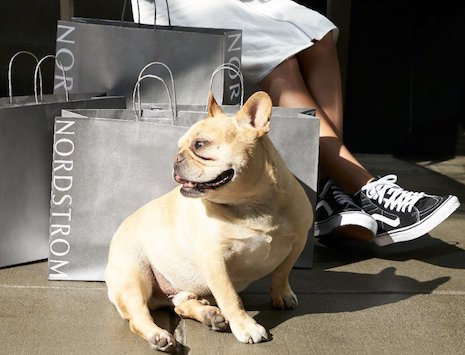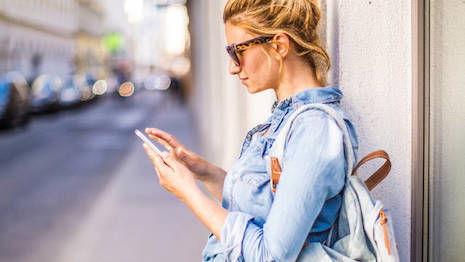Loyalty program members are more drawn to program experience rather than end rewards, reflecting the overall shift of consumers favoring unique services instead of material objects.
According to Bond Brand Loyalty’s 9th Annual Loyalty Report, rewards only account for a quarter of loyalty member satisfaction. Nordstrom’s Nordy Club and Hilton Worldwide’s Hilton Honors are among top loyalty programs based on overall member satisfaction.
“Many brands are still focused on the myopic points versus the moments that matter most along the entire member journey,” said Sean Claessen, executive vice president of strategy at Bond Brand Loyalty. “Essentially, for younger consumers, it’s all about the experience.”
Bond Brand Loyalty examined more than 900 loyalty programs across sectors and surveyed more than 50,000 U.S. consumers for its report.
Program expectations
Consumer enrollment in loyalty programs is on the rise.
According to a report from CrowdTwist, consumers who have incomes greater than $100,000 are more likely than average to seek discounts through loyalty programs. They are also more apt to quit a program if they feel they are not getting relevant rewards (see story).

The Nordy Club launched in 2018. Image credit: Nordstrom
More than half of brands, 56 percent, use aspects of game mechanics in their loyalty programs, including goal setting, countdowns and virtual rewards. Eight in 10 members use these features when available, and are twice as likely to enjoy participating in the program.
As consumers share more personal data with brands and loyalty programs, their expectations for personalization increase.
Only 20 percent of members are satisfied with the level of personalization from participating loyalty programs.
By improving personalization, brands can be rewarded with more satisfied loyalty members and higher rates of spending and engagement. Consumers are six times happier with brands that successfully personalize their loyalty programs.
Personalization is particularly important for millennial and Generation Z consumers. Fifty-nine percent are comfortable with programs using their information for authentic, purposeful and meaningful loyalty experiences.
Millennial and Generation Z consumers are the demographics most likely to be highly influenced by loyalty programs, at a respective 71 and 65 percent.

Younger consumers have different expectations for loyalty programs. Image credit: Resonance
While many loyalty programs are free to join, more than half of younger consumers are also interested in paying a fee to receive enhanced benefits, compared to 43 percent of all U.S. consumers across age groups.
“As loyalty natives, they are also highly influenced by programs so paying a fee is not a surprise for a group that is seeking more tailored and relevant experiences,” Mr. Claessen said.
Loyalty leaders
Consumers with higher incomes are more apt to be part of a loyalty program than their peers, pointing to the potential benefit of these membership clubs for luxury brands.
Last year, Nordstrom revamped its loyalty program to include additional personalization and more convenient ways to shop.
All Nordy Club members receive early access to brand and product launches, attendance to beauty and style workshops and free basic alterations. The benefits are not limited to cardholders, making it more appealing to younger shoppers who tend to eschew credit cards (see story).
As third-party booking Web sites such as Expedia continue to disrupt the travel industry, hospitality brands are reinforcing the value of direct booking and long-term relationships and updating their loyalty programs.
Waldorf Astoria parent company Hilton Worldwide recently recruited actress Anna Kendrick to star in a new series of advertisements touting the hospitality group’s revamped rewards program (see story). Hotel group Marriott International recently launched Bonvoy, a loyalty program that covers 30 hotel brands, including what was once Marriott Rewards, the Ritz-Carlton Rewards and Starwood Preferred Guest (see story).
While not geared exclusively towards affluents, Amazon’s Prime membership remains the standard for loyalty programs. It is also an example of a program that requires an annual membership fee.
Amazon’s annual Prime Day, which has deals reserved solely for Prime members, generates billions of dollars in sales for the online marketplace. During the sales event, Prime-enrolled shoppers can find the best value on the retailer’s own products, as well as private labels in various categories (see story).
“Loyalty programs are a very important component of the marketing mix, and for most brands comprise a key part of a consumer’s relationship with the brand,” Bond Brand Loyalty’s Mr. Claessen said. “What drives member satisfaction with a program and engagement with brand relates to the experience, and this is especially true for luxury brands.
“Loyalty, when properly designed and effectively operated, provides brands with a means of identifying and understanding customers, such that the experience delivered to members not only embodies the virtues of the brand, but also delights members and authentically meets their needs,” he said.
{"ct":"pW1XE1J+PFUJ37ZZck+Pvy12fEL+GE383NDvjj9hzpKXy6PqlxZ9Y44QHJ8X13ICVyBqLfOiQ9kDv3SdG+0\/ueS\/k0+wfC49cQ2lorBj5Ancm8y+1RWutPgA8Q0Hw3u5Zcw0KzQDp7NBUhaKVREBt3\/2sIjUwZ45Trh5q8VN77851YW+6dlN5UijGLknpjue95AZJGVMraNVJyfCjrU8kby1LfJqlRjM1dnGfGm8ZRSX\/zNpeMP8XcsSEryw5UK5woIVxcy4trqwjlSAyVzFz\/u3nZVcF+aA1wCqBHu6mHl9FoZr8bNDhp87TYt2mYVAkpt5IRYx7UDKnDPLl6\/qwxWBPMeutmGYurS1jvn9iPvDInafF+d3k+C9IZAncWFBmc\/t+DC7I7kpTmYSB4fYIATF0T4O6kxK\/0dLTS5bZeAOgSlYdu\/8KSWa5SKYtcVHV7l7Sa9h+SJjLIj3t4JE1QsbT7iezMc9xbXVh0zwyXNxke8wi8JI5S95J8mah2\/s2ZdTnncpYRGRrv8Ri65q\/n1+5PSzerqDv82z4nRkQXhksGPDE6TsfstTBWnWmt\/EtN1xj5W7IwR1wYwbcsG\/Y9clSVlsAqH3XBisYyr44tHRfGETGZ9xyH32TDwIE8E1Ja2+V2XEg\/r1oyGjtYfaxSJ3pDDikJfbWfL8prBjDcjSz0q1dc5rwdh2QZVUesOqEwd9GfKYLrv4rTvdJdZUPrDl44Box+emCuFsHuGpSd2JEVlZgAf7Ogm7ZpzSvjx3rMd8BtWlbashHKrZthnPHKWQc4+p9xHTJkUKWz+kMZR6AvqXb073N5960ZyaXt\/cO9robCPNFvqMAOweuS5tmmOf0Z4NU5eIvQ0OQwgoO3VFOCdbuBk6ZHhl9d3A\/I\/DOAFAeg70q5TA0GsHrN7notLQlu4VG\/PbOzbToKTrsRICS6cYWMt\/S\/0BuqXvganAuP+8F0TpRftKaEGviJebsujaoHiuSxAaLUXAGUBJQ84D8yWtiqUbUD60ACDKpMJ+Odtj0zC0r\/8dwfVbHZdr7Uk1yQsCgmBVc5gxcuoIyHGUUoK2ej\/IGgr3Jfz+ewhULaSTLmlrUDHW+\/2GR2g4a+pbj5FtaB+hZo2TZoPQ0wZif\/0798YF0WYqk5adZOxKnVjSI3ac1BYAjCP9AKJF9vIC4SuoK4\/AEsaA4D58XaaeP7CzqSywyzTH6NOFp2lkbxXGXKD7bOIlEXxq3fOq7xw+pUkW65pQo8DLYXstQLPaq1y\/hdXJsZCzo35lisQJG3p4BorwcfnGiIBxGZ2VwLI0PIC9vRJljW7LvnwrNrHX60XcWxejmWUgkde55Ps3t\/+MV0Y3nMxpHhZ5VQkvjT\/FBnoMi0k03BXEoaFXfAT6Yh008WVqppu8F7EjCaQzvBFNQgd2HelBOZZ\/XpLDq\/nobF5g1nQIUa7tI+XxlcuSmF3aFzqz4lgeHaJ62MYIW6dYtquNuVvyucBg\/mCK55UrN2KrQozm1d8cjh1fm5GgRFPwF6xTu8efG1tZqSazRMft5s\/bkQeN5BT57\/kUpJrBtqRUYjyzIe2Mml2604r858ZkekL2ViRXx7gv4jx7XaA64I+3bJLuodw4LuSoqGnTr06ZRXwZ2vuBV5lAwvSU6FSycftF8yGggStVV9IdkpZjoz2D1Y945m6JD09E44e3JPDfnh+ZQTokL48OhBWFCnaxeewFskYVFFBtkNz32czZJl0LNGarJYUv7NnFD2XjOmoyPl7R3II4fe5kpn2ZVdMRpzgoPueRuDIgmqILuAk4gO103Mex8khNyZ2onPzIRel0cOIoSPz267BeRmAaJTI0eE6+u0uouLmfc7mENsH0m0rcGrp9imm3jzrutQU\/0+4kUgLoyJ4rCzKisKIgziMeXhgjuFibKy\/Kl9D0svyQVRAE+rAf44ZDFlVKv1Oqq2QPhYv+WV1KHoGvftcy\/54DOCZ3GVs6DWrURDh3MvopfXj6F1BoWZZIUu14EcztVSOwofk0Ds8u9vnQQ8fHB1F3q+rqWeM0xcTX75lsLz6pb1Xk5YybMyT93EvnyI0qBusfkhi80sxqL0izbrPpynUXbrsksF+erKCYxcTZzzoP9gd9OQO4TW1pppXM3\/j+v2xL+xZ+Jz3lL8J3ltx4jZd5sDEjXOpDDoN3jTYiK++RvMkkTgFtVYIRAjxQZeWaVB1a83cWTweMGnfGf5MxIHnzwx1eNdInfUwhqNfbHY7CwU5PFCb9Dgkng+C45u+GZGrkfWSrSNrzkvfUvpOnrd8hNZfkJLZW47jJJYen1JaDQwDxZNdvhA68dLdhqaCdJZpFnr60ehoatnp6IHtHI6Zh2Fg76PaO50sAl+Acg4Ig7oZ4LocfLlAreN9YNeicEiQ28Q+Xqxz5Er8EQM6MlDi9G3b5qo9wveeZXb4UAQqn8WMo9tTt9u8pD+mv4iYY94Gg+inkLGT6vYfGGCkxRsWX\/vWQQA6pgsHebys9phvPTA82QfF4S0LMyxva+ER6CgwQLhVcyPsigASdfm5\/e34KnNSYj9G3To8quGicE6vo6\/+dElU0dcG0\/3WdjMSS1U9FYsSj0eHQa\/PsWoireZaOvOxZm+YbjMNBpUicsV\/Y8\/15rhkn53r5f2NhpqmUWM7aohff++VyYtx6uJ6Szk8HWsLELtQkYmD1eBC+9jG7J6GwF3LVY0bau3MenTV\/\/dIk+eGgnQUH0tvVB\/dlYynAR3wkCCc8LZGY\/ulvb\/cS1eLuvU+j1sxr+\/0RWP8wF\/yN4QJR9LiYWjcZa+2TcxoLuXT8hKWIiZGCHhnhIIiQ6hc17jGkwjrE35Mq5sILHepLUSHgQVnRtsUQNIdmSxMW7rP9LDqWA3tp7wMbDY94zAAgxeoNCvfybv\/yDdHQ\/b0MPB8hxjGaNxiNHukxhaxxo21yurcVjJ6zdHz8gYw\/N2pxVk2ddm8UkfGrVEhaWqAG4B00ov+5BVKA1icaoA26YaZAxPzZ61qWAstGMUjAMs1j6zQxUEShgeB5KFeyQexDWz+SCsus5vpl2pe3Y5PEovZlpzdBOkMluIGYHebCrqn8PDFbNWv7c+xNT1mkjzW0jInGwMmFU+OLQtyOnXTUbhQxxhzbMVv50fmTJQd2PKbFH7spXL+ntzz\/R9ZyNpx06OjPhLHeByLH6PZ\/ckl4KQsREoFInSKdhT46gr4TkFb4We16evCzqw\/LOm02a1BIUbkhBgXMaLTrs1DP8gyxefD6yljVv3D3rQdIU4ZRRdQyMBb0+C\/3y0IhKVmNyAf7erBziQUEXuRhXo3WnZ3uaxZzAkebTVgcwmLMcagK92JN6EsC80YPFywBW8k5zoGepLEKzwfdIU0y0Os9BKmQN6v\/TUO3NpJ1bcx\/aY+voRLQp+P8oAYHt5Dwy2AgnSiZKpWZ6RfXK0TQgNLIOuC8r1FsRdbB6MEn30I4q3baMX5YNq6P5IX7GYFGGaWlM90K2USiryJffrNdBZGxs3jfmeOYT0qkdu3RpZIe0NFctvyXB3OPJQ2Lx00nFdYal5lumYN53cRMrlu347mlA597IEPDtvo\/v4iOOJ3j13EAioBy7ppqL2yUchyTEECVKRI3aSenG8grq5a8d8iOxqJT1kcjxlUU51JCzO\/2846kaQHuD+haIRyIPlFHI21fIAME1WPp3iaA968IpbgnIYPHl9FLyhi0IAkbKuOaLVXl7TW3lOBlPhHGtX9t0xyZscv79qUlkUXwyu4u1ALySApVzaf8CxICJynLyfzQWgGkpHbI2hEOAPuVey3uuHZLGbGdDFxDtyrqRlQWwW03sp0L4oyKIddhmPYfSLEUq41vUlaFf2kn9LipFUBbPRQvazpbUgWehxL4GUUMpqU+ShxgISnzGVqhQ8byGAVGfxqB3PqclnDSyjIyoTfKF43aVGCDACl30bTlkbXk5dmwLwfHFuBcFs\/fR0oninIVI5cN3eT+lqCQnn9a5QEsH1FG+Fd8HVyVUwUaMw2Zj2\/zzBnDJIT1Io3hOZ\/wWXUbJSsB9MCDZPmg23q+6c0QeGBimxhrz3U603eFR1+quLulAdhYu4DFkGgM754NPm69tUcvF8tamkdORnC4NR35x9BjMtjGDqqeJHuVKJcEMTVb2SYMYVEyDON6lNdWwhSS+AysqYsVYWu4rLmKWwjMRjEUXuxBNDu6sfiQ35J\/F5MTDpqzUEhkPmFduCkiD95Bwd9QeNWpVpxoS0DCGjDwcIzi00351Wj+rLkv+5qpYSmDoSxS98TNQCDZ0o83hRmxOWKeLF6GOLi0sHMF2aVqMuv0lHD7KWpGZ0EAEJ\/E7lXhxQEyTNZhZRHP9MAgWp2bnmtTrgKfTar1mBGeEcDGf7CSx4EeKHlIoW3FL4EHSc1hBrPKNmrkwE3433qgQ0JGWvLtij4BQ9NMksm7BUmdvQw0tfs+RzUA6a11t1TP1BBcFa4GrhcXTWXmSB7FQQ9icorgr0r67Za7memP+Hlam\/v4BpHJ6jxmfxmOoWXuoqi+YS4UbsCjCn9+o22YlZrY0ggvKXoQEmLk12S3eFSxg2gaJqjwtQQRcypJkZnhny9T5l4KCJ7GAp2E0iq\/UZ9ovHrwed5MbNQmzcsSnyt0ny3dEldkARIRI0Cx2zYHK12WdlWWy+7onIdw3LuBQdks3pmfUpd2NuQKIXGM4LVn4l2SWeAb7A0qI7xKRcXkRvAtvthUGI4TDR4y21b4HY0ouW3owO4MKTJvrsNVy6aKnJgLReoKYIbJO6B5OJ7oDUjBqKwRnV7AB\/Kdp6QYhYIRHgf4nRrNERWSlz2V3gs\/R848FgFYVguESgZZEEXWDCxIe6ogb9TsRg2qZDm4eneFrYZJUc7NCAPq96vcxdGmPQ5yk\/dVD0CA93vPGTcjA+1b5f+UUqqUH++zPee7r1rJI2dIafm56KOSvNnHcxFfITxubKV2LFq08pk74S7JZSRvfpumMUeFgWM87yOv3zmjbUpy8gU8THuqocJU+cj55Gfv79GoRjQqmtx48kv5T3VrN7\/7uDk\/qrZpXdmWGPkPhrcaSR7QL7oCzmp1H6Ugw1eGGFCpShOSlMHH0zohyy636RKmjMIeKdrWLE6Ja5pJAmcm4ue81FCQQmabwOHp582rnuTSkRZndwdd5fjF479qknC9nN+ntU89MEQsvSRSVVChw2DGKgVSGFamA0Faed\/ahs5aBlln7hr8n7XG0sJ3pD0o9T92rZdTAzNkQLybILz++X0j5YNdh5OqTIUWVMIGGFoXanhBTEdJXvtNfpLxnz4nK+8q0AXm2yYGxu+8nVN4mdSRiAeVKd+0RzprN+WHwZD977MEqEuRk6\/cgK5mREFwIzUYj8TMn1xLqRJbfeGZSaCF3TSGexMr3IwLPkaNX5GQntdN\/0JWODuob1Lj9Y9PCs1\/tgE2icReh0QVkbpO2KCGmK7bpI0xrd52AvtANpHEe+QCC26K3pXOM8M7g1vxnqUs6zox6WQRC25biIx6mwgY+QzUnzrpKPxomyxKruKEWvi6n1Rl\/nGjJLnwgyZ1z\/ORyOrP7LPKgCwlHKSEA+ksOfS9jMavMH76wknS1V7gEglqKWsb3o3LKQMGwHo5B61nKrQgjlu88XCyXp+7CYMJJ4+W1TAh\/CUSOg+VlYyAWMgD0NZN3T+3fh+TzuE5+VAnL9ZhTdSFnW9tNnLScebPhFcsyqtANGihBASaeY7fzmMT2hWLTRwUBbL1YaUPmWLO5ZpVeH2THyMvKe6fLJFleTeYz\/TgDIYOBYqr9Lo25MZT4wXdhZNHeaU53y1H7wsuYBgtx6FhcWR5jfKWrayMnnSheCEclR3dsHOHbIV5Z83usKyId7C8EpzAp+elGCIYFIdCU+J+xWXqU5vJCBXO\/AAELC3nio0wxQIxLVD10f\/P7A8ymDqwwOfh2ty1s8RJgMoLLnDEBSsFAjlncqCCqj1WYCnPe3SwJRIpfY95L3oqzI6xLe9RQ9Z4Dzs7N0iDoHLgXf1dV5Nm6bdSkmD4d9gwcsbjOYTu\/8eYDwwZ9AHmrZk\/ePAzT7W2X0WbatsDJV98WCS5kFcvBchZTamMoIvbc4M\/4lW96IeVi5hEqRFBHSq9ab29vOfbd4kw\/L5y4mfB+YB7xM4g5fJ3mSX+zxnDNLGz4H9NyjQfnIOEjDSqBJzvWmpj353iHGD\/2HIBp6nPKyfCy\/q6G5StRgeUWJE5f4GbCoTd3U8A30EKVeXJrQEtN60mlW4a9UO3AIruk9TALwkkxunUBONwvtZ5kq2N9AU2agfz5L9rMhHD2zeR3595yj8F+0ljJ6ptGsQyBY0v1e2xm07m1Z1VkuFFRm76KIKYQ6UBn0h0eNTUbnZktIwzQAYAPBucrZynRIsXRNZD9lZFXRyW\/DQtt2ELCC878dL7KivLo5jyPFx0OW5zE+60kx84tbLGpQHr4D4oc5opj+I8An6QUQE\/laH6fz5sdf9sflDjeqQoTNrQ4oaZ8UXlZiVunLtMrnfGdeMf37ey8zQybj3sOgkW7Ezw1CvjWDAclshNmiaa52RpBdZlHzZJTyhxXDjNPUD9cxuN2wcI03NncMLtxgXW2E9xSu5mzPaxCwLwBzDN2u680p5Hvy1T+vAiWEYABHnEckD5plLqYEh1vMxlNUBKICds6XCFx3bL05T8bCE22\/Lb8bd+uz3gxnTSonOiPCYOvKqBHjspSz7ie11a2RXLu+MJpu6pzTzgg3dCpiJcGz2vgpY208srRx\/Paa0M3E6NCaR\/0kGxmjcRPQZ7ErKSBxaK4Qs1FQEdO+m6STJShOz9MMDA5lZJdyWyvvlGs69UZIQ1b0\/FU5TqMjPLckhwLXMpFKWtLVzZbnnzDZ84BMVlsD+te0z9yETkrQcI+bm0C7hVY5\/A0boRhAq+n6ZrH\/AGXvSDcRdOguIwVRBOqk300BrEJWe88c+laLA6Z7mdNdHvHevtLLgLHukYRkG2Tc8qnbjbeCBqAZsIF6w5dwfi5rQhOxTJB4hb2GZa61yDQJ72IF5dV2TdjyUZsensSKl+aTjfkRD2ULvGXx8gAor69rhaOYPRW7M1uJppIrlTtWYemxXpa9bJpY1jGB98BRz86FgVJO1kSkTwtxjiMFSb\/35K67f2p+4L7X+grO+AJr8GRoogB8F8zro9jfLES00eRU6cyhbx70lille2qalFOREGohsziRY2fKDUbMvvyl4Tpz3QY+CmBJ9xhHew0iEOpCGfAp3TsAoK4YFNJflsWpBaGSSLtmtIA3C\/LiUIUu63Jl+nyqBzll6\/UdAZ4ECw\/fB\/1ipV0DPb3BaT6UDxuxlqzsYmUX9tGIbLYpg+5ljbJ+4lFtc2EUUztwz5CBU8qSCYzZI64wHIAHXQuLgKnpGLyAst+hkERjyRsGGWW0cQhiyaxBmIFstAYDwgtIa8fCW8QWnhPpsU5gdE+Z1ERgBK+Nnb4Fm6cvlStCA3j3d4RObciOu9k4LQ+qEQfigUgyOIVKDoHT8G2l+\/MKeR\/lqxt23npqufxXEHZVb7y\/ytbwK5JbwmchWuAzGlmZR\/GOyQtRKiL45ocMyvFhPRqfkv27jP5asyp+gy+J0kUB+lACpxMHS5S5FT4yfYQfz16NdMtHK3Epfm+ad8SwTvR2qVduSzb1OjNsuZCx7EGEsYIP7ipku8fVmFRHhHQrOr+ZjEKEacQtJzmLpD+54ot6N2UEH2hDNEQt8RmgJhPeuDx3bYfHtqiVlmYZLTJH9QfylNlyDEM8gzfyPOJDY1SnkiP2L87SXojr35O\/dwSSv7ttZeO2WzTdvNTxVmSCRS7T4NBwfI5LeHilY5yWThv6kRuhJCPaVjQrYMYe2atpdcjwfi\/FUTxbz9DE924V44Vn+3vFFvs9feLSM49LlqtjFIadrXW6O\/rdr5GIFHN6eoMjRj\/mLXGM0P26Tw2DSm2bl9FIIugWY3PwoihRdq2olUh06lrl6vuq0vkjA9w\/bNChDXhgm54+MkwhqmEKXxn7LTho2++bZPjCmORC5Dp0tKIKt8Ra1ydxWESs6lTZ04ZCKGMgHfeNmfJuNFxlW73fWbfgdOhVuXQnVjXMt1z4jAMKIGDy25WllDgPNCsnxT5XF+\/sIpPO97SagEY1xDiVaJ5uRRedeZ0f5eHC0Eia7m3g7QuKK5KF9lQgy\/iU1IGHC\/Jx5FMu7pB0XwYcRI2qEXAn6EP\/TRnVopcBoEL6OTC+UUsSGZjWVAY6P8GD56KVm5qNoXlQZ1xeBsmqHNfDlNRd+Su5UYA68eqwT74T8SaR\/sH6MsH6TOzwYB7FxRmGPaSQggGhkQb1cKxYk4O1vQzl3TxpVn+r\/G7W+DxyiFMw555uGBfW3dVZ615S7a4dSdhWWbmAaY4DCUZDGV7lEf2KqripEjymDY+ylUCSYaoXSDhlr6iKIr9wZ6YnFwd2ulRT5iDaXMbppqeaO0s1G0sqL7jVsR9\/S+eE7LGwo+UVaPUBF6ixqZFOIm2SMO78rmCI9R\/J2mjRyhZEvgBrwWfOQ6JTdkeXrkr6fYB\/zmk1O2Ztn1HVwUOSxeVQR5HvxyA\/MR51bS5aI6UZVkiBCoMfvGW67MhkSUKA5\/8fN29xwQ2V9tPW7gZzijeW88oKlHROj4D7h82yJwJ5pEyUpE7+JMPPHDm5GEHP6CliM7SW25fslaWKNI193l5R1WK0YfkZFgFKku9NV6uKNTVb0t2yq7W0A19cdvVw0B\/5xqqaeWJN47JllQ3RLJqLbOFD315L3zsmBV5A2V78In8Jr2EARMCQgcf45Ll8vaj39zwPa5xWfAkHXhlmku2W3+Y4WJH05c8B1f1FRPNebNSDoknYAcGFCfh7Xab5B1x4axQOVxfxEUJE0X5IdH0jQNXBIghOVMNeAEgh2cb6cBr0hnkjZH2PPZP\/1crITng4BeZeG7dc+QgIYxfcxDYIYhckLyFWg3wJF3fl057Rnk7LrK8aCtor63A4\/tbaxED9j8vDLo7XxqZigEBvObNQWt8m\/CvbG+xtldafrqI2bb0Rlrhi8bhw0\/CbFKFp8hzeuG9JcxoLVmj0LWFmm8ZgT8puVGOpLLhi2zpXLS9fu46GrjJXTMwnkJWUVidCAVO0g40KW\/lXuG\/Rdp3DRQts6lweHYosO23a7xAhm5qg2y2vLVVfzoGoOJTqes\/c1imwcAERwBZE3buCZkjqAyyPpvD+ZCmnVtzdw5rNZPfost8303AbQBWZL4UxXvY\/WPKeFs+p21EoWPizjQSbt2xr5Ta8C6xsg20cReKyqVYGjD3amgTgvtc0pjrG00ujaeVyc3xJkKkW2FfkbvNZdwqEavrxMMzP6UDBZ+mcSFMWKqcrrWL16Pfh8G477GOPwL36RDP3FtacLxcAE=","iv":"33bdb642b11f15b436709d4e56ebf47c","s":"e181200ad04d0485"}

 Consumers across different age groups want different things from their loyalty programs. Image credit: Lancome
Consumers across different age groups want different things from their loyalty programs. Image credit: Lancome